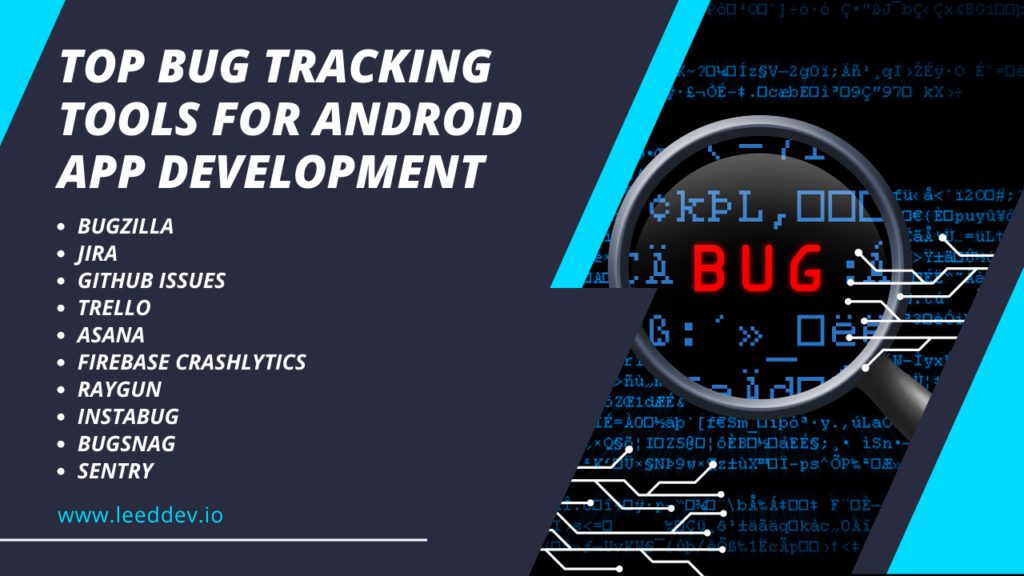Track and squash those pesky bugs with ease! Let’s say hello to the bug tracking system for mobile development. Don’t let bugs hold your app back. Every system or app often runs into some kind of bug or issue. And everyone is tired of dealing with these irritating bugs in the project. But now you can track, manage, and squash bugs effortlessly with the given intuitive and user-friendly android bug tracking systems. No more endless back-and-forth emails or confusion over bug reports. Now it’s easy to stay organized and gain valuable insights with the given bug track systems.
Let’s discuss the process of how to set up the best bug tracking systems that will fit your needs. This will help you collaborate seamlessly with your team and stakeholders, ensuring everyone stays on the same page throughout the bug fixing process.
Read also: How to Choose Mobile App Development Company
What Is Bug Tracking Software?
Bug tracking tools or bug tracking systems for mobile development are designed to help users manage bugs at every stage of the software development life cycle. Bug tracking software also referred to as an issue tracking system, constitutes a software tool meticulously crafted to aid development teams in effectively managing and monitoring software bugs. These invaluable tools play a crucial role for Android app developers during the testing phase, empowering them to meticulously track and address issues and bugs within their projects. The provides a centralized platform for capturing, documenting, organizing, and resolving reported issues or bugs.
Why Bug Tracking Systems are Crucial for Android App Development
Bug tracking systems play a vital role in the Android app development process. They allow developers to log, track, and manage bugs throughout the entire software development lifecycle. By using a bug tracking system, Android app developers can:
- Efficiently Manage Bugs: Bug tracking systems provide a centralized platform to log and manage bugs, making it easier for developers to track and resolve issues.
- Enhance Collaboration: Bug tracking systems facilitate collaboration among team members by providing a shared space to discuss and address bugs. This improves communication and ensures that everyone is on the same page.
- Streamline Testing Process: Bug tracking systems help in organizing and prioritizing bugs, making it easier for testers to focus on critical issues and streamline the testing process.
- Improve Software Quality: By identifying and fixing bugs early in the development cycle, bug tracking systems contribute to the overall quality of the Android app. This leads to a better user experience and higher customer satisfaction.
How to Set Up A Bug Tracking System?
A brief overview is given below to set up bug tracking system for Android Development:
- The first step is to identify and define your requirements
- The next step is to choose a bug tracking system for mobile development that fits the needs of the project.
- Now you need to customize the system to your needs. It’s important that you specify the workflow, preferences and requirements of the team and project.
- You also need to prepare your team to use the system.
- The last step is to test the system and for this you need to create different test scenarios and simulate bug reports.
- Now verify whether the bugs are being reported correctly or not.
Top Bug Tracking Tools for Android App Development

1. Bugzilla
Bugzilla is a widely-used open-source bug tracking system that offers a comprehensive set of features for managing bugs. It allows Android app developers to log and track bugs, assign them to team members, set priorities, and track their progress. Bugzilla also provides customizable workflows, powerful search capabilities, and detailed reporting options.
2. JIRA
JIRA is a popular bug tracking and project management tool that is widely used by Android app developers. It offers a wide range of features, including bug tracking, issue tracking, task management, and agile project management. With JIRA, Android app development teams can easily track and manage bugs, collaborate on projects, and visualize project progress using burndown charts and Kanban boards.
3. GitHub Issues
GitHub Issues is a bug tracking system integrated within the GitHub platform, which is widely used by Android app developers for version control and code collaboration. It provides a simple and intuitive interface for logging and tracking bugs, assigning them to team members, and discussing solutions. GitHub Issues also allows developers to link bugs to specific code commits, making it easier to trace and resolve issues.
4. Trello
Trello is a popular project management tool that can also be used for bug tracking in Android app development. It uses a card-based system to organize tasks, making it easy to track bugs, assign them to team members, and set deadlines. Trello also provides collaboration features, such as comments and file attachments, allowing team members to communicate and share relevant information.
5. Asana
Asana is another versatile project management tool that can be used for bug tracking in Android app development. It offers features like task management, collaboration, and project tracking, making it a comprehensive solution for managing bugs. With Asana, Android app developers can create tasks for bugs, assign them to team members, set due dates, and track their progress.
6. Firebase Crashlytics
Firebase Crashlytics is a powerful bug tracking tool specifically designed for Android app development. It provides real-time crash reporting, allowing developers to identify and prioritize critical bugs quickly. Firebase Crashlytics also offers detailed crash reports, stack traces, and analytics to help developers understand the root cause of bugs and take appropriate actions.
7. Raygun
Raygun is a comprehensive bug tracking and error monitoring tool that helps Android app developers detect and resolve bugs quickly. It provides real-time error reporting, detailed crash reports, and performance monitoring. Raygun also integrates with popular development tools and frameworks, making it easy to track bugs throughout the development process.
8. Instabug
Instabug is a bug reporting and user feedback platform that offers bug tracking capabilities for Android app development. It allows users to easily report bugs and provide feedback directly from the app. Instabug captures screenshots, screen recordings, and device details, making it easier for developers to reproduce and fix bugs. It also provides collaboration features, such as in-app chat, to facilitate communication between users and developers.
9. Bugsnag
Bugsnag is an error monitoring and bug tracking tool that helps Android app developers identify, prioritize, and fix bugs. It provides real-time error reporting, crash monitoring, and detailed error logs. Bugsnag also integrates with popular development tools and frameworks, allowing developers to track bugs across different platforms and environments.
10. Sentry
Sentry is a cloud-based bug tracking and error monitoring platform that offers comprehensive bug tracking capabilities for Android app development. It provides real-time error reporting, crash tracking, and performance monitoring. Sentry also offers advanced features like event grouping, release tracking, and issue assignment, making it a powerful tool for managing bugs.
Types Of Bug Tracking Systems
Choosing the best bug tracking system for mobile development depends on the requirements and needs of the project. It’s necessary that the development team chooses the right type of bug tracker to optimize the workflow. Following are the main types of bug tracking system that the development team uses to reduce issues and identify bugs:
Open Source Bug Tracking Systems
Open Source Bug Tracking Systems is a free bug tracking system that offers free and customizable approaches for identifying bugs. These systems are made available under an open-source license, allowing developers to collaborate and work together. Such tools are typically developed and maintained by a community of developers and offer a range of features. They provide a platform for development teams to effectively monitor, organize, and resolve issues and bugs encountered throughout the software development lifecycle.
Pros and Cons
The disadvantages and advantages of bug tracking system for mobile development are as follows:
| Pros | Cons |
| Allows users to access the source code, promoting transparency and accountability. | Limited official support channels compared to commercial software. |
| Can be customized to suit specific needs and requirements. | Users have to rely on community forums or documentation for assistance. |
| Users have the freedom to adapt the software to their preferences. | Customizing open source software requires technical expertise and may be challenging for non-technical users. |
| Available for free, reducing licensing and acquisition costs | Steeper learning curve compared to user-friendly commercial software. |
| With open source software, vulnerabilities and bugs are often discovered and fixed more rapidly | Integrating with existing proprietary solutions can sometimes be complex and may require additional development effort. |
Cloud-Based Bug Tracking Systems
These tracking systems are hosted on remote servers that can also be accessed through a web browser. Cloud-based bug tracking systems encompass software tools meticulously designed to track and effectively manage software bugs. These systems operate within a cloud computing infrastructure, offering a convenient and accessible solution. Such systems can be accessed easily anywhere if a user has a stable internet connection. Through a web-based platform, development teams can seamlessly monitor, meticulously document, and efficiently resolve the issues and bugs encountered throughout the software development lifecycle.
Pros and Cons
The pros and cons of cloud based bug tracking system for mobile development are as follows:
| Pros | Cons |
| Can be accessed from anywhere with an internet connection. | Potential security risks associated with storing bug data in the cloud. |
| Enables efficient collaboration among team members, even remotely. | Concerns regarding the privacy and confidentiality of bug data stored in the cloud. |
| Easily scalable to accommodate growing teams and projects. | Relies on stable internet connectivity for seamless usage |
| Often integrates with other development tools, enhancing workflow efficiency. | Reliance on the bug tracking system provider for updates, maintenance, and support. |
| Provides real-time updates and notifications on bug status and progress. | May have limitations on customizing workflows or functionalities based on specific team needs. |
| Offers a centralized platform to track and manage bugs effectively. | Subscription fees is required |
Commercial Bug Tracking Systems
These are paid solutions that are user friendly and offer advanced features. Commercial Bug Tracking Systems are designed to offer robust features. These systems are specifically designed to assist organizations in effectively monitoring, managing, and resolving software bugs and issues at every stage of the software development process. Such systems are often used by businesses and software companies to ensure high quality software products.
Pros and Cons
The pros and cons of commercial bug tracking system are as follows:
| Pros | Cons |
| Offers a wide range of features for efficient bug tracking and issue management. | Typically involves upfront costs and ongoing fees, which may not be feasible for all organizations. |
| Regular updates and improvements, ensuring that organizations have access to the latest bug tracking functionalities. | May have limitations on customization, restricting certain workflow or feature modifications. |
| Allows scalability as the team and project size increase | Users may require time and training to familiarize themselves with the system and its features. |
| Integration with other development tools, enabling a seamless workflow and information exchange | Concerns about storing bug data in the cloud and relying on the system’s security measures. |
| Provide robust reporting and analytics capabilities, offering insights into bug trends, and process improvement. | Switching to a different bug tracking system may be challenging due to data migration and compatibility considerations. |
| Many commercial systems offer automation features, such as automatic bug assignment and notification triggers. |
In-House Bug Tracking Systems
In-house bug tracking systems, also referred to as on-premises bug tracking systems. These systems encompass software solutions designed to effectively manage and track bugs. What sets them apart is that they reside within an organization’s internal infrastructure, where they are hosted and meticulously maintained. Unlike their cloud-based counterparts, in-house bug tracking systems find their place within the organization’s own servers or local network, operating seamlessly within that confined domain.
Pros and Cons
The pros and cons of In-House bug tracking system are as follows:
| Pros | Cons |
| Provides greater control over operations, allowing the organization to set its own standards and priorities. | Implementing in-house operations may require significant investments in technology, infrastructure, and training. |
| Ensures sensitive information and data remain within the organization’s secure environment. | Limitations in scaling to accommodate increased demands, requiring additional resources. |
| Allows for faster decision-making and response times, as internal teams have direct access to information and resources. | In-house operations may become outdated or less efficient over time due to rapid technological advancements |
| Facilitates seamless integration with other internal tools and systems. | Requires ongoing maintenance, updates, and support, which may increase workload and cost for the organization. |
| Utilizes the skills and knowledge of internal employees who are familiar with the organization’s processes and systems. |
Conclusion
To conclude, a bug tracking system for mobile development is essential for Android app development as they help developers manage and resolve bugs efficiently. By using the right bug tracking tool, Android app developers can streamline their development process, enhance collaboration, and deliver high-quality apps to their users. In this guide, we explored the importance of bug tracking systems and highlighted the top bug tracking tools available for Android app development. Choose the tool that best fits your team’s needs and start squashing those bugs!



